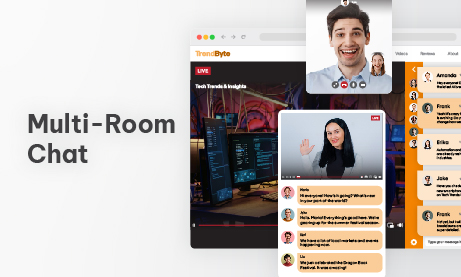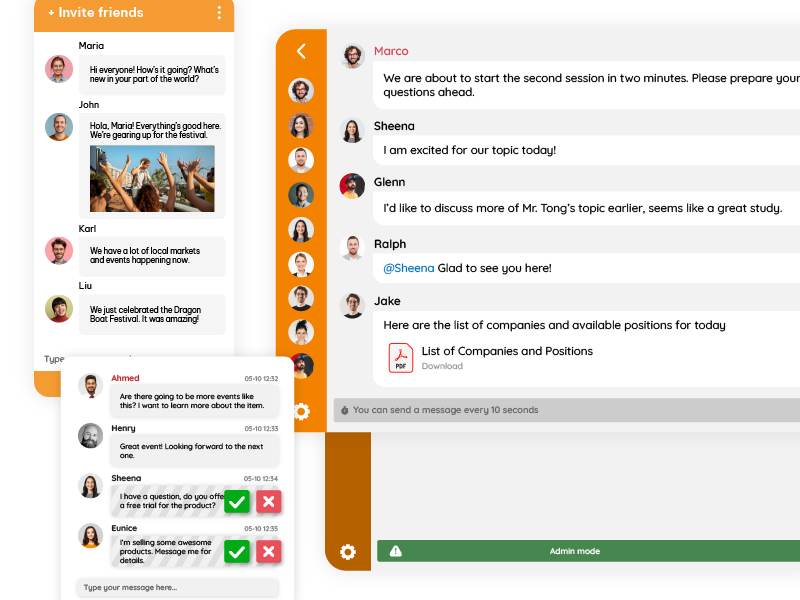Hosting a great virtual event isn’t just about streaming content. It’s about generating real interaction and making your audience feel part of something live, connected, and meaningful.
Most event organizers quickly discover that one chat room is not enough. When hundreds or thousands of people join at the same time, a single chat stream becomes noisy, chaotic, and impossible to follow.
The answer is multi-room chat. Multiple rooms running in parallel create structure, control, and engagement for events of any size. Whether you are hosting a conference, a product launch, a job fair, or a tech summit, multi-room chat transforms passive viewing into an active social experience.
This article breaks down why multi-room chat is the secret ingredient behind successful virtual events and how you can use it to build a professional, organized, and highly interactive experience.
Why One Chat Room Isn’t Enough
Imagine 1500 attendees joining a virtual keynote. You enable one chat room. Within seconds, hundreds of messages flood the page. Questions get lost, introductions vanish instantly, and moderators scramble to catch up.
A single chat room collapses under pressure. It creates friction for participants and frustration for event organizers.
Multi-room chat solves this by letting organizers divide conversations into relevant spaces such as:
- Keynote Q and A
- Networking lounges
- Breakout sessions
- Topic-based discussions
- VIP or backstage access
Each room stays active, but focused. Attendees join the spaces that matter to them. Moderators gain control. The event becomes smoother and more enjoyable.
Real Examples of Multi-Room Chat at Virtual Events
Multi-room chat is widely used across the event industry. Here are real RumbleTalk examples that show how event producers are using multiple rooms in practice.
Online Conferences
A large digital conference used one main room for announcements and several smaller session rooms for individual speakers. This helped attendees move between sessions without overwhelming a single chat. Moderators controlled questions across all rooms at the same time, keeping discussions clean and organized.
Job Fairs
A virtual recruitment event used different rooms for each department Engineering, Marketing, Design. Job seekers spoke directly with the relevant teams instead of competing for attention in a single general chat.
Product Launches
A tech company launched a new tool and created separate rooms for Q and A, customer support, and advanced training. Users could choose the room that matched their interests, making the launch feel like an interactive event instead of a one-way webinar.
Live Radio or Broadcast Shows
Radio shows that stream online use multi-room chat to keep the live broadcast organized. One room is public for fan messages, while another is a private internal room for hosts and producers to coordinate.
These examples show that multi-room chat brings clarity and structure to events that require many simultaneous conversations.
Moving from One Room to Many A Smooth Discussion Flow
One of the biggest advantages of multi-room chat is the ability to start discussions in one place and continue them in smaller more focused rooms. This mirrors the natural flow of real conferences where everyone gathers in a main hall and then splits into breakout sessions.
A typical flow looks like this:
- Start in the main room for greetings and introductions
- Move into breakout rooms for deeper topic discussions
- Hold private or group sessions in smaller rooms
- Return to the main room for summaries and final remarks
Moderators can guide users to the right rooms with announcements or pinned messages. Users move easily between discussions without losing their identity or needing to log in again.
This flexible flow makes virtual events feel dynamic instead of static.
Adding a Video Broadcast Next to the Chat Room
Every impactful virtual event combines video and chat. With RumbleTalk, you can embed a video broadcast window like YouTube Live, Vimeo, or any custom player directly beside the chat room.
This creates a complete event stage on a single page:
Video on the left, chat on the right.
Attendees watch and talk at the same time. Speakers see reactions instantly. Moderators escalate important questions quickly. The audience stays engaged throughout the entire event.
Pairing chat with a broadcast window boosts both participation and attention.
Multi-Room Chat for All Types of Virtual Events
Multi-room chat is incredibly flexible and works for almost any kind of digital gathering.
Tech Events and Hackathons
Organize rooms for coding teams, mentor feedback, idea pitching, and general announcements.
Job Fairs
Let job seekers join the department room that fits their skills. Recruiters get clean, focused conversations.
Webinars and Product Launches
Keep general chat separate from advanced Q and A or feedback rooms.
Training Sessions
Run classes with separate rooms for quizzes, discussions, or project groups.
Community Meetups
Segment rooms by region, interest, or activity.
Multi-room chat helps you tailor your event structure to match your audience.
Hybrid Events When Physical and Virtual Worlds Meet
Not all events are digital. Many in-person events also require a virtual presence. Multi-room chat makes hybrid experiences easy.
Here’s how it works:
- Remote participants join the chat online
- Their questions appear on a big screen on stage
- Speakers address both physical and virtual audiences at once
This setup is ideal for:
- Conferences
- Q and A panels
- Concert interactions
- Live workshops
Hybrid events feel inclusive because participants from anywhere can contribute directly to what’s happening on stage.
Multi-Room Chat Moderation One Team Managing Many Conversations
When you have multiple rooms, you also need a team that can manage them efficiently. RumbleTalk lets moderators oversee many rooms at the same time. They can:
- Approve or reject messages
- Pin important announcements
- Filter inappropriate content
- Move between rooms from one dashboard
- Act on behalf of the event owner
This structure makes large events run smoothly even with thousands of attendees. One moderator can manage several rooms, or you can assign a team for full control.
It’s scalable, fast, and ideal for multi-session events.
WordPress Integration Adding a Multi-Room Chat Easily
If your event site is built on WordPress, adding multiple chat rooms is incredibly simple with the RumbleTalk WordPress plugin.
Here’s how it works:
- Install the RumbleTalk plugin
- Connect your RumbleTalk account
- Each room you create appears as a shortcode
- Place each shortcode on a different WordPress page
Example:
[rumbletalk-chat hash="room1"]
[rumbletalk-chat hash="room2"]
This allows you to build a multi-room virtual event layout with no coding. Each page becomes its own chat room. Visitors move across rooms as if navigating a real conference center.
Paywall Events and Auto-Login Seamless Access for Paid Attendees
Many virtual events require ticketing or membership access. You can place your chat rooms behind a paywall on your website. Once a user logs into your site, the chat inherits their information automatically.
This is done using the RumbleTalk Auto-Login system:
https rumbletalk.com support API Auto Login
Your website sends the username to the chat securely, creating a smooth login experience. The attendee logs in once on your website, and the chat welcomes them by name.
This setup is perfect for:
- Paid webinars
- Premium training sessions
- VIP events
- Subscription-based communities
It feels professional and requires no extra steps from attendees.
REST API for Developers Create Rooms Automatically
For platforms that need advanced automation, developers can use the RumbleTalk REST API to:
- Create chat rooms dynamically
- Assign roles
- Update settings
- Add users programmatically
This is helpful for event systems that automatically generate new sessions based on schedules or user actions. It does require developer knowledge, but it allows full customization and automation when needed.
Advantages of Multi-Room Chat for Virtual Events
Multi-room chat brings clear benefits:
- Cleaner and more organized discussions
- Higher engagement and participation
- Better moderation control
- Ability to support thousands of users
- Smooth transitions between sessions
- Easy integration with video, WordPress, and paywalls
Multi-room chat creates the structure that every great virtual event needs.
Best Practices for Hosting Multi-Room Events
Here are proven tips:
- Plan room structure early
- Assign moderators to each room
- Encourage movement between rooms
- Pair chat with video
- Test everything before going live
- Use analytics to measure participation
These practices ensure your event feels professional and engaging.
Members Only Events Exclusive Experiences With Controlled Access
Multi-room chat is also ideal for members-only events. These are exclusive gatherings where only logged-in or paying members can join. You decide who sees which room.
A members-only event setup can include:
- A private main room for all members
- VIP rooms for higher-tier subscribers
- Special Q and A sessions with limited access
- Training rooms available only to specific groups
- Networking rooms restricted to verified members
When combined with a paywall or membership system, you can ensure that only authorized users participate. With Auto-Login integration, the chat automatically displays the user’s website login name, making the experience seamless and secure.
This approach is perfect for:
- Premium education communities
- Paid masterminds
- Exclusive clubs
- Investor groups
- Online training programs
Members feel valued, protected, and part of something special.




